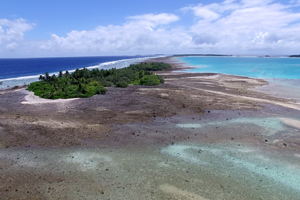Climate change: Small islands to face a freshwater scarcity
Current global climate models fail to take into consideration the evaporation taking place on small islands, says a new study, overestimating the amount of freshwater likely to be available to their populations in the coming decades.

Aerial photo of Mili Atoll (172E, 6N), Republic of the Marshall Islands taken by a drone during our recent fieldwork in the western tropical Pacific.
Jeffrey P. Donnelly
Island populations are likely to face much greater scarcity of freshwater in the coming decades than previously thought, according to new research.
Current global climate models (GCMs) indicate that 50 percent of small islands will become wetter, and 50 percent drier, by the middle of the century, but this new study, published Monday in Nature Climate Change, contends that a more accurate estimate puts 73 percent at risk of increased aridity.
The basis of this substantial discrepancy is that current GCMs tend to have a resolution that is too coarse to consider any islands much smaller than New Zealand's, which means that while they are able to account for rainfall, the effects of evaporation from land remain ignored for small islands.
“The basic issue underlying this is that people need water,” says lead author Kris Karnauskas of the University of Colorado, Boulder, in a telephone interview with The Christian Science Monitor. “It’s fairly fundamental, whether you’re living in the middle of continental USA or Australia, or out in the open ocean.”
What he found, however, was that in many Intergovernmental Panel on Climate Change (IPCC) reports, there were plenty of “beautiful maps” that considered the aggregated amount of water, but “out there in the ocean,” there simply was no data.
Rainfall was accounted for, but as Dr. Karnauskas explains, this only represents one side of the coin, the other being evaporation – nature’s supply, and nature’s demand.
“Only knowing one of these is like saying the Red Sox scored nine, but we don’t know what the Yankees scored,” says Karnauskas. “What good does that do you?”
To address this problem, the researchers used the GCMs that seemed so blind to evaporation on small islands and applied a technique borrowed from civil engineering, which allowed them to calculate evaporation happening on an island without having to know any of the variables inherent to the land surface itself.
Using the GCMs, they looked at the “bubble of air sitting above the islands.” The models provide data for myriad atmospheric data that would impact the evaporation from the land’s surface, such as wind, temperature, and solar radiation.
From these figures, the scientists could indirectly assess the likely rates of evaporation for small islands in various climatic scenarios in the decades to come.
These island nations – or island areas of larger nations – already face substantial pressures, some of their own making, others due to global climate change, such as sea-level rise.
Population growth, which this study left aside, is set to explode in some of these places, placing even more strain on natural resources.
“Underlying all this is a bit of a social justice issue,” Karnauskas tells the Monitor. “We can’t really hold these small island nations responsible for climate change, when their contribution is so negligible.
“Hopefully this information will be helpful out on the ground as islands plan for their future needs.”

